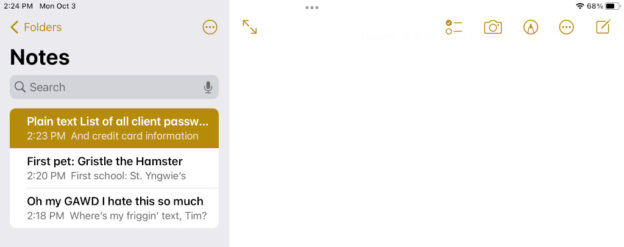The crime against humanity that is the modern OS desktop, and how to kill it
This is an opinion piece from The Register, and I agree with it completely.
And of course, I have thoughts.
Doing more, worse.
After 30+ years of development–and more important, marketing–we now have a rich, competitive market of 2 commercial desktop operating systems that are widely used. Yep, a whole two. Great job, everyone!
As the version number of each of these operating system increments up, more features are added to them.
For the last 20 years or so, the new operating system features that get the most attention (and more important, marketing) are things that were previously done by applications that were separate from the operating system, or things that could be separate from the operating system.
This includes stuff like ways to buy and play music, or ways to buy and play podcasts or ways to buy other stuff or see stock prices or buy and play games, or my favourite: ways to buy applications that allow you to control how your operating system operates
[I snipped out my inevitable rant about misusing monopoly positions without meaningful repercussions, “a fine is just a price,” the subtle (and sometimes not-so-subtle) difference between selling “ease of use” and hiding important decisions from the user, and the similarities between “Buy your mom an iPhone” and just letting her eat cake–all my greatest hits. BUT I DO TAKE REQUESTS!]
Meanwhile, both the experience and the functionality of the basic operating system get continually worse for the average user.
What’s so bad about Windows/Mac OS?
Oh, I have lists of what is terrible about desktop operating systems, as does pretty much everyone. I am not dumping that out here.
If I start listing things that suck about one particular operating system, the conversation will quickly turn to an argument over which operating system is better or worse. That’s not what we’re doing here, and it’s also pointless.
[FWIW, I use FOUR different operating systems (I am SO interesting, aren’t I?) on a very regular basis, and given the choice, I use one of them more than the others. I haven’t thought of that one as “best” for a long time, though. It’s just less-worse. If you can muster a reason why the other one is less-worse for you, you are correct.]
What I am saying here is that, while these features keep getting added (and coming soon: the ads keep getting featured) to desktop operating systems, the core functionality–what an operating system should do for you at a minimum—and more important, the experience of using that functionality—is getting worse or at best, not improving.
No matter which operating system you currently consider the least-worst, your file manager still sucks, you can’t do some basic things you want to do, and other things seem much more difficult than they should. Every time you get a new computer, or a new version of an operating system is foisted on you, it requires you to spend a bunch of time trying to figure out what has changed, and how to do things you used to know how to do.
Here’s what happened: Instead of being a platform on which you can build an environment and set of functionality that lets you do whatever you want to do, desktop operating systems became platforms designed by and for what other people would like you to do.
OK, but how does this relate to Four on the Floor?
To illustrate what I mean by this, invoke the nice easy search (“start” if you bought a computer for Microsoft, or CMD+spacebar if you bought one for Apple or [Prolonged Argument over what is the best distro/desktop/window manager that somehow involves systemd] if you are using Linux)) on your desktop computer and type in “Change IP address” or “Add a drive” or “create a new directory.”
Does the desktop operating system you are using take you to where you can accomplish this task in that operating system?
or
Does it use its awesome weeeb integration to contact a search engine on the 1nternerbs and return articles that may or may not give you instructions on how/where to do the thing you want to do on your operating system?
It’s the latter, isn’t it?
Yup. I checked.
That search on your machine could absolutely be set up to do the former. It could learn or be updated to help people more easily find the things they need to do on their computer the most often, or even to know about upcoming changes they might need to make, and make those changes easier to make.
The only reason the search on your operating system can’t do that is because the people who make that operating system decided to do something else instead. Instead of making your operating system easier to operate, they added those other features, which you paid for.
And that’s why your awesome desktop operating system can much more efficiently find you the filmography of Jimmy McNichol than it can help you actually operate your system.
Cool story. So what can we do about this?
You can always find the solution on the Internerts.
